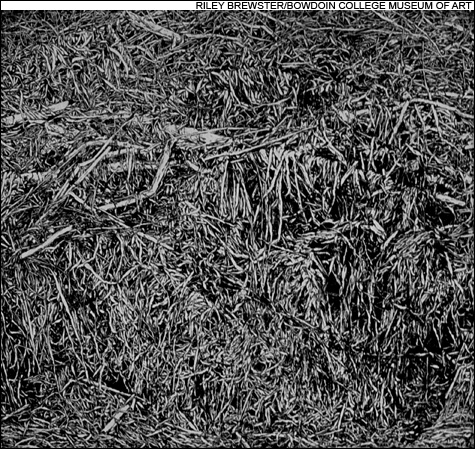
"WRACK" By Andrea Sulzer, 20 by 24 inches, ink on paper, 1999. |
| "Andrea Sulzer: After Nature" through August 27 | at Bowdoin College Museum of Art, Brunswick | 207.725.3275 |
By way of a conflation of technical detail, careful curating, and an evocative personal story, a small solo show of Andrea Sulzer’s drawings and woodcuts at the Bowdoin Museum of Art, entitled “After Nature,” is nothing short of riveting. Each of the 15 works in a small gallery tucked well into the museum contributes to a sense of a remarkable artistic development, a narrative of evolving expression that is inspiring to witness.Sulzer has been making art professionally for only a little more than 10 years, when, at the age of 37, she left her position as a laboratory instructor in the biology department of Bowdoin College. To see work at each stage of development over this past decade of new exploration gives us a rare glimpse into how a fertile mind and technical ability can evolve into mastery.
“Nest 1” from 1999 reveals the seeds of Sulzer’s practice. A clean, aerial perspective of a nest is rendered in drypoint with great attention to detail, akin to that of a field drawing. The nest sits perfectly positioned on the paper and is delicately embraced by a white background full of subtle marks and smudges from the printing process. The gentle marks push the composition away from detached scientific observation, making the nest a center of gravity within the picture plane.
“Wrack,” from the same year, shows us another constant rooted in early work. The same observational eye is put to the test to create an astoundingly realistic rendering of a bed of seaweed. Sulzer pulls the compositional frame very close to suggest an endless band of the organic mass as the individual plants continue out of sight off the slightly tattered edges of the paper. Close-up inspection is rewarded but the beauty is also in the undulating forms of the wrack when seen as a whole, suggesting the choppy ocean that gives the seaweed form.
“Edenkoben” and “Garden” from 2001 represent a significant shift in direction. Both evince the same attention to detail and play with dense, natural relationships, but Sulzer replaces her thin line with bold brushstrokes of ink to insinuate garden growth. A freeing up of space paradoxically takes place through the loose filling of the paper. These pieces feel like more of a bridge in artistic process, breaking open the artist's preconceptions of composition and line.
By 2006, Sulzer has hit her stride and combined both her tendency to detail and her sense of broad composition in “Spillway.” Two scroll-like strips of paper merge like a diptych on a grandiose scale. Minutiae built up from organic pods and visceral hatch strokes are rendered individually to form a swirling expanse of monochromatic curling fractal forms, a teeming bacterial colony as seen under a microscope. On closer inspection, the conflicting tides are seas of soldiers, loosely rendered so as to be barely recognizable but unequivocally brandishing medieval lances or rifles, marching in swarms. Our species’s capacity for self-destruction is viewed as a vast story where flocks of birds are juxtaposed with large figures next to Lilliputian masses. At times, the density moves toward total darkness and a converse negative white space. The whole work, which seems to be derived from the artist’s ongoing improvisational drawing process, turns the mess into a balance of yin and yang energies. All this destruction seems to be a living breathing organism of its own, albeit with apocalyptic undertones.